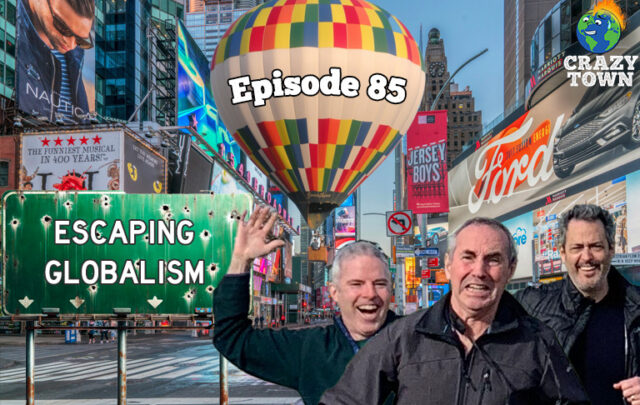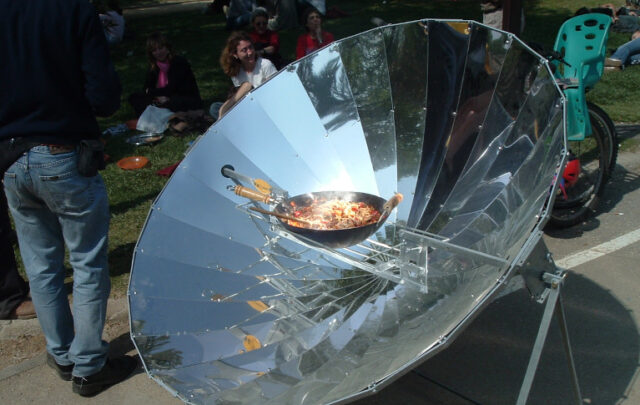NOTE: Images in this archived article have been removed.
 I am traveling from Seattle to London by bicycle and boat. Read the intro to my travels on Grist.
I am traveling from Seattle to London by bicycle and boat. Read the intro to my travels on Grist.
On Montana’s northern plains, some organic growers’ neighbors reportedly began referring to them as “weed farmers” a few decades ago. These organic pioneers had started to seed small, green plants in hopes of strengthening their soil. These little leguminous plants were nitrogen-fixers, species whose roots host nodules of bacteria that bring nitrogen from the air into the ground, converting it to a form usable by plants and thus fertilizing the soil without industrial chemicals. To conventional grain farmers, though, it seemed peculiar, perhaps pathetic, to intentionally grow plants that looked like the ones they tried to eliminate from their fields. In an agricultural culture that glorifies pure, unblemished waves of erect-standing grain, raising puny legumes and purposefully intercropping multiple species in one field appears unmanly, an affront to the dominion over nature that God has granted humanity. Or at least that’s what I learned reading Liz Carlisle’s book Lentil Underground while taking a break from bike touring.
Neil Baunsgard and I are exploring this world of organic grain farmers as we cross Montana’s north by bicycle, part of a
west-to-east transcontinental journey. At our
first stop, Rick Winkowitsch’s farm just north of the town of Cut Bank, the immense scale of grain production took us by surprise. How our grains are grown affects a lot bigger land area than, say, the organic veggie farms we support at the local farmers market.
But whether organic methods could make dryland grain growing truly sustainable remained unsettled, in my mind. Chemical-free farming is clearly a lot of work, both in terms of human labor and fossil-fuel burning. Leaving more variables in nature’s hands meant a lot less guaranteed success, it seemed.
And then there’s tilling. Organic farmers in Montana typically turn the soil before seeding a crop to quash whatever is currently growing there. Tilling soil exposes it to erosion, disturbs its microorganisms, and can cause moisture loss — a big deal in a region that gets just a few more inches of rain annually than a desert.
Rather than tilling, conventional grain growers can simply make a quick pass with the sprayer to exterminate weeds in preparation for planting. Applying herbicides keeps the dirt in place, preserving topsoil, moisture, and tiny life. Yet herbicides can be harmful to the farmworkers that spray them and the broader ecosystems they infiltrate. Organic and conventional systems both have upsides and downsides.
We quickly learned from Rick’s land that being an organic “weed farmer” doesn’t just mean intentionally growing species that look like weeds; it also means constantly battling weeds that really aren’t welcome, since it’s super difficult to eradicate unwanted flora from one’s fields without the help of chemical herbicides. To make matters more difficult for isolated organic growers like Rick, the weeds have evolved incredible resilience because the herbicides that the conventional-farming neighbors spray wipe out all but the very strongest weed individuals, whose progeny then populate the land. Vegetative invaders don’t pay attention to property boundaries. Visiting Rick’s farm became a guided tour of the cutting edge of chemical-free weed control in Montana.
Rick was particularly proud of his V-blade, a machine that cuts off weeds’ roots withoutturning the soil. The V-blade allows Rick to plant his grain seeds six inches deep and then run the machine over the whole crop, slicing existing plant life just two inches below the soil’s surface. The nutrients and moisture from weeds or cover crops that inhabited the field previously then return to the soil. With the right conditions, the new crop gets a head start on competition, and can bask in full sunlight and shade out competition below.
As we continue our tour across Montana’s “Hi Line,” every organic farmer we visit will want to tell us about the biggest problem weeds in their neck of the plains, and their innovative methods for dealing with them. Rick speculated about the potential to use steam or heat to kill weeds without plowing. One organic farmer featured in Lentil Underground even ordered a spider-like machine from Austria that can pull up shallow-rooted weeds right in between rows of growing grain.
Mostly, organic farmers control weeds by carefully crafting crop rotations — if you grow the same crop a few years in a row, perennial weeds will become established. Alternating nitrogen users like wheat with legumes that put nitrogen back in the soil, for example, meets one ecological need of the land, so there’s no open casting call for unwanted plants to come perform that unfilled role.
Most growers in this region also include a “summer fallow” in the multi-year cycle, when they don’t seed any crop and allow the weed seeds in a field to germinate. Then, organic farmers till these weeds back into the soil before planting the next crop, hopefully eradicating any pest plants that have established themselves. Summer fallow in dryland farming also allows the next year’s crop to have more than one year’s moisture at its disposal. With no crop sucking up water, only to be taken from the field at harvest, the soil can hold on to some of that wetness for the following growing season. Northern Montana east of the Rocky Mountains gets less than 15 inches of precipitation per year, so fully utilizing every last drop of moisture is critical.
Yet — counterproductive to the goal of preserving wetness —
tillage can cause moisture loss through evaporation. And after tilling, bare ground can’t absorb rainwater as well as soil with some greenery on top. Reduced moisture is a high price to pay for trying to control weeds in an organic system.
Rick’s V-blade, which undercuts weeds without fully turning the soil, which would expose it to erosion and moisture loss. Photo: Neil Baunsgard.
The next evening, after about 70 miles of pedaling east along Highway 2 from Cut Bank, Montana, Neil and I meet an old-timer named Arlo at a summer picnic in a tiny town called Chester. During an engaging conversation about everything from the regional effects of climate change to Seattle’s urban planning, we learn that Arlo’s family farms winter wheat, spring wheat, peas, lentils, feed barley, and malt barley, a diversity of crops much like many of the organic growers we’re visiting in Montana.
I ask Arlo why his family started growing nitrogen fixers with their grains, expecting an answer about feeding the soil. Instead, Arlo begins an in-depth explanation of when, where, and how he injects nitrogen fertilizer into the ground with a grain crop. He stops himself after a minute or two. “What was the question again?”
“Why did your family start growing legumes?” I ask.
“Oh, the lentils get sold to India, mostly,” Arlo replies. He goes on about the grain elevator down the road that we had just biked by, how he delivers lentils there to be hauled by train to the west coast for shipment around the world. His answer is all about growing what can be sold on global markets, not about growing what’s healthy for the land or the life it sustains. And yet, growing lentils and peas for financial reasons doesn’t make their root nodules fix less nitrogen. It’s good to hear that non-organic growers are diversifying their farms, too.
Then, unprompted, Arlo tells me about “no-till” farming. Rather than tilling weeds back into the ground after summer fallow, Arlo sprays them away with a jug of Round Up — he stretches his hands wide to show me how much of the herbicide he uses.
Chester, Montana’s Thursday afternoon picnic in the park, a much-needed hearty meal before the homestretch of a 98-mile day of cycling. Photo: Neil Baunsgard.
Neil and I ride off into — er, away from — the sunset with the perception that farming with chemicals is gross. Our liberal upbringings and environmental education has taught us that Round Up is unequivocally bad, as is its manufacturer, the agribiz giant Monsanto. Arlo served as a caricature to reinforce our bias against business-as-usual industrial agriculture.
But there must be another side to the story; local extension agents, conservation groups, and government ag agencies like Natural Resources Conservation Service all support chemical farming practices. Patrick Hensleigh, Montana’s NRCS state agronomist, tells me that he believes no-till is simply a better system than what he calls “conventional tillage,” which is practiced by organic farmers. “The chem fallow certainly will hold more moisture,” he says, referring to the practice of eradicating weeds with herbicide instead of tillage during a fallow season. Moisture is clearly the all-important limiting nutrient for plant growth here on the dry plains.
Hensleigh prefers no-till practices to organic farming for more reasons than just moisture. “Every time you till, you’re affecting soil microbes, especially fungi, which take time to establish,” he says. Yet organic advocates have repeatedly insisted to me that spraying herbicides creates a sterile soil environment, which makes intuitive sense — applying a substance that’s supposed to kill living things should kill tiny living things in the ground, right?
The view over our shoulders as we pedaled away from the late-night summer sun in northern Montana. Photo: Neil Baunsgard.
We bike 28 more miles, making it our longest day on the trip thus far, and arrive in Hingham, Montana, just as dusk falls. We’re staying at a house that belongs to my Uncle Mike, who trades pulses — lentils, chickpeas, and other “grain” legumes — on global markets. A resident of Spokane, Washington, he bought the place in this gravel-road town to keep an eye on possibilities for business; the region is fast becoming a production hub for lentils and peas. In fact, Montana — far from its typical twentieth-century cycle of wheat, wheat, and fallow — is now the number one producer of pulse crops in the United States. Conventional growers have followed the organic movement toward seeding a variety of crops, with solid results both economically and environmentally.
Clark Jones, who farms a few plots of land across Montana’s north, has diversified his farm more than most farmers, growing mustard, peas, safflower, and corn in addition to the typical array of grains. Alternating between an assortment of crops with different attributes has allowed Jones to eliminate summer fallow from his rotation, a rare feat in dryland farming. Instead of letting fields sit naked, Jones allows subsurface moisture to accumulate the year before seeding a water-intensive crop by planting shallow-rooted crops that don’t require as much moisture. And keeping the ground covered ensures that when precipitation does fall, it gets absorbed into the soil rather than running off.
“It also helps with the control of weedy species: By rotating the different types of crops, from broadleaf to grassy crops, you’re able to use different chemical families to help control the weeds,” Jones says. Plus, he tells me that he is able to apply 20 to 25 percent less nitrogen fertilizer on a cereal crop following a nitrogen-fixing legume like clover or lentils, reducing the
environmental (and
geopolitical) impacts of producing and using synthetic nitrogen, which
really screws up ecosystems when too much gets in the water.
Jones says no-till farming has virtually eliminated wind erosion and greatly reduced water erosion, too, because there’s always crop residue holding the soil in place. Despite the price of organic wheat hovering around four times that of conventional wheat in recent years, Jones hasn’t seriously considered transitioning away from chemicals. He follows the guidelines issued by university extension services to make sure he doesn’t over-apply chemicals, the same as any farmer concerned about limiting costs.
For the eco-conscious grower, the ultimate goal might be to prevent weeds instead of killing them — to create the perfectly harmonious, robust farm ecosystem that holds uninvited visitors at bay. But right now, farmers have to choose between tillage and chemicals, between farming weeds and poisoning them.
There’s no right or wrong answer; investigating the trade-offs and how farmers navigate tough decisions is the interesting part of this tour of dryland farming on the northern plains. Tools like Rick’s V-blade can help organic farmers disturb the soil less, while farming biodiversity can allow conventional growers like Clark Jones to summon more sustenance from the earth with fewer chemicals. The sharing of knowledge about farming in a smarter way may be more important than strict adherence to organic or zero-tillage standards. As my Uncle Mike texted me when I told him I was writing about organic farming in Montana: I’m still not sold on organic; most people can’t afford it. Basically, it’s complicated.
 I am traveling from Seattle to London by bicycle and boat. Read the intro to my travels on Grist.
I am traveling from Seattle to London by bicycle and boat. Read the intro to my travels on Grist.





